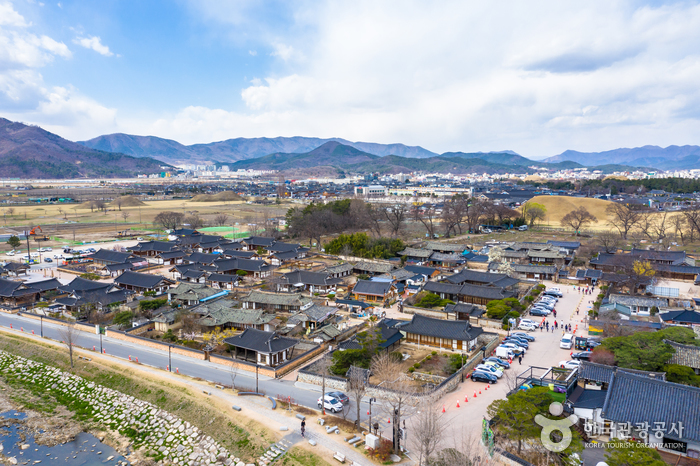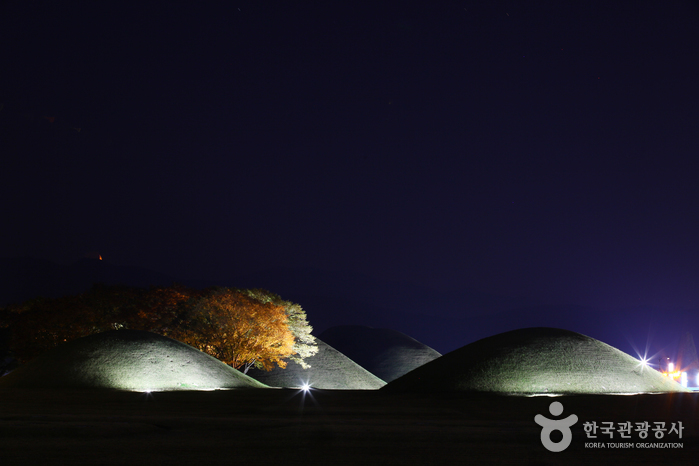Gyeongjuhanok 1st [Korea Quality] / 경주 한옥 1번가 [한국관광 품질인증]
0m 948 2021-04-05
20, Cheonwon 1-gil, Gyeongju-si, Gyeongsangbuk-do
010-9505-5367
As a new hanok guesthouse, Gyeongju Hanok 1st is located at the entrance to Cheonwon Village, Gyeongju, Gyeongsangbuk-do. It has various modern amenities while preserving the features of a traditional Korean house. The guesthouse is kept cool in summer and warm in winter, so guests can experience the traditional Korean house. It has various rooms in different sizes that can accommodate 3 - 8 people. There is a stand-alone guesthouse furnished with kitchen and bathroom as well. All other rooms also have a bathroom inside, but the kitchen must be shared among the guests. There are no beds in the room as is typical of a traditional Korean house, but there are high-quality sheets and blankets for the comfort of the guests. The guesthouse has a large front yard with a miniature traditional Korean house with dolls adorned in traditional clothes, not to mention other traditional artifacts. Popular tourist destinations within the vicinity of the guesthouse include Anapji Pond, Cheomseongdae, and Gyeongju National Museum.
Wadamjung [Korea Quality] / 와담정 [한국관광 품질인증]
18.324039802269485m 814 2023-04-13
18, Cheonwon 1-gil, Gyeongju-si, Gyeongsangbuk-do
+82-54-772-5400 / +82-10-6571-3412
Wadamjung in Cheonwon Village, Gyeongju is a modern traditional Korean guesthouse built in May 2017, with both the features of a traditional Korean house and modern facilities such as air conditioner and bathroom. It has a total of nine guestrooms that can accommodate three to six people, and there is a kitchen that can be shared among the guests. A large group can book a stand-alone guestroom that can accommodate up to 12 people, inclusive of a kitchen. There are various traditional artifacts and items with which to play a traditional game in the large yard, such as Jegi (Korean shuttlecock game) and Tuho (Arrow-throwing). In addition, there are a number of tourist destinations such as Cheomseongdae in Wolseong District, with lots of historical sites in Gyeongju as well as Gyeongju National Museum.
KELIMGUNG [Korea Quality] / 계림궁 [한국관광 품질인증]
230.42989692132087m 14099 2023-04-13
932, Poseok-ro, Gyeongju-si, Gyeongsangbuk-do
+82-10-2705-8121
According to a Korean myth, Gyerim Forest in Banwolseong Fortress, Gyeongju is the birthplace of Silla Kingdom founder Kim Alji (of Gyeongju Kim’s Clan) about two thousand years ago. Gyerimgung Hanok Pension is located 2 kilometers from Banwolseong Fortress and is named after the forest. Inside the gate are guestrooms named “Yoseok Room” with a large window in the detached building, “Sirim Room” and “Alji Room” in the main building, and “Asadal Room” and “Asanyeo Room” right next to it. The guesthouse has a shared kitchen and two “wondumak” (a Korean lookout hut on stilts usually in a melon field for guests to use). Barbecue facilities are also available upon reservation. The guesthouse offers a number of fun traditional programs including “Starting a Fire for Traditional Korean Iron Pot,” “Neolttwigi,” and “Yunnori.” Gyeongju Oreung in the vicinity of the guesthouse is a great place to take a walk. Nearby popular tourist destinations include Banwolseong Fortress, Cheomseongdae Observatory, and Daereungwon Tomb Complex. The guesthouse can be a great choice for those looking for a quiet place to stay overnight because it's situated in a residential area slightly off the main tourist zone.
Aldea Tradicional Gyochon en Gyeongju (경주 교촌마을)
460.9598955352798m 26483 2020-10-12
Gyochon-gil 39-2, Gyeongju-si, Gyeongsangbuk-do.
+82-54-760-7880
Situada en la ciudad de Gyeongju, la Aldea Gyeochon es un pueblo de casas tradicionales hanok que permite a los visitantes ver la vida del famoso clan Choi. Los visitantes pueden ver su casa y probar el licor Beopgju Gyodong de Gyeongju.
Gyeongju Oreung Hanok [Korea Quality] / 경주오릉한옥 [한국관광 품질인증/Korea Quality]
500.8964354887157m 2 2023-04-13
12-17, Gukdang 2-gil, Gyeongju-si, Gyeongsangbuk-do
This hanok (traditional Korean house) guesthouse is located right across from the Five Royal Tombs in Gyeongju. Because there are no obstructions on the way, the guesthouse enjoys a remarkable view of the ancient city. Located about 2.5 km from Gyeongju Intercity Bus Termina and about 2 km from Gyeongju Historic Areas, this guesthouse has a dignified yet comfortable atmosphere.
It is run by a mother-and-daughter team, whose attention to detail and care can be felt tangibly in the comfortably furnished rooms: well-maintained lawn and trees, double doors that help to prevent drafts and noises, and clean white bedding appreciated by many visitors. Rooms with ondol (under-the-floor heating system) are ideal for two. From walls covered by traditional Korean paper to clean and comfortable bedding, the room exudes comfort. A raised floor space in front of the room is a great place to see the scenery and a great place for photography.
Another strength of Gyeongju Oreung Hanok guesthouse is its accessibility. Hwangnidan-gil Street, a bustling street full of restaurants and cafes, is only a 15-min walk away, while Gyeongju’s famous sights such as Cheomseongdae Observatory, Daereungwon Ancient Tomb Complex, Donggung Palace and Wolji Pond, and Gyeongju National Museum are only a 10-min drive away.
Puente Woljeonggyo (월정교)
533.1476903136219m 16 2023-09-20
Gyo-dong 274, Gyeongju-si, Gyeongsangbuk-do
Festival de la Cultura de Silla (신라문화제)
553.1949992166547m 6951 2023-07-24
Gyo-dong 274, Gyeongju-si, Gyeongsangbuk-do
054-777-5953
Desde 1962, el Festival de la Cultura de Silla ha sido una celebración cultural significativa realizada en el Parque Hwangseong, y el centro de la ciudad de Gyeongju. Es un festival cultural que convoca al espíritu del antiguo reino de Silla, que supo tener una destacada historia y cultura. También presenta la visión de Gyeongju de ser un espacio de intercambio cultural y turismo. El festival les permite a los residentes y turistas unirse bajo un ambiente de interacción positiva, expandiendo asimismo la imagen de Gyeongju como sitio histórico y destino turístico cultural con una herencia milenaria.
Yosokkoong (요석궁)
638.9404029144969m 53073 2020-07-14
19-4, Gyochonan-gil, Gyeongju-si, Gyeongsangbuk-do
+82-54-772-3347
Named after Silla King Muyeol's daughter, Princess Yoseok, Yosokkoong serves traditional Korean food. The resturant is run by the Choi family, who settled on the site of Princess Yoseok's house during the Joseon dynasty, and has passed on the restaurant and family recipes through 12 generations. All the foods served are made with organic ingredients, for a healthy taste that cannot be found anywhere else.
Tumba Real del Rey Naemul de Gyeongju (경주 내물왕릉)
869.3785445481934m 18618 2022-09-19
Gyo-dong, Gyeongju-si, Gyeongsangbuk-do
El rey Naemul fue el 17º monarca del reino de Silla (en el poder de 356 a 402) y se convirtió en el segundo rey de la familia Kim. El rey Naemul fue conocido como el primero en iniciar el título de rey de “Maripgan” y fue conocido por difundir los avances culturales de China al pueblo coreano. Cuando atacaron las fuerzas aliadas de Baekje y Japón, pidió ayuda a Gwanggaeto el Grande de Goguryeo y llevo a la gente a la victoria, contribuyendo al aumento de la fuerza del Reino de Silla. Después de su gobierno, el trono fue cedido exclusivamente a miembros de la familia Kim.
La tumba del rey Naemul es un montículo grande (22 m de diámetro y 5,3 m de altura) y se encuentra en la colina norte de la Escuela Neoconfuciana de Gyeongju. Un borde de piedras naturales se expone alrededor de la parte inferior del montículo, lo que apunta al hecho de que la tumba de la cámara interior estaba hecha de piedra. En el documento histórico Samguk Sagi (Historia de los Tres Reinos), no se encuentran registros sobre la tumba, pero el Samguk Yusa (Memorabilia de los Tres Reinos) describe la tumba del rey está en el suroeste de Cheomseongdae, que coincide con la ubicación de la tumba.
Bosque Gyerim de Gyeongju (경주 계림)
928.812047254939m 12239 2023-02-20
Gyo-dong, Gyeongju-si, Gyeongsangbuk-do.
El bosque Gyerim se encuentra entre el observatorio Cheomseongdae y la fortaleza Wolseong de la ciudad de Gyeongju. El bosque está densamente poblado por antiguas zelkovas y sauces arraigados en suaves colinas y a lo largo del pequeño arroyo en la parte noroeste del bosque. Según la leyenda, el bosque está estrechamente relacionado con los mitos que rodean el nacimiento de Alji, el fundador del clan Kim de Gyeongju. Como tal, fue designado Sitio Histórico Nacional.
La leyenda cuenta que el rey Talhae escuchó a un gallo cantando desde lo más profundo del bosque Sirim. El canciller Hogong fue enviado a investigar. Al llegar, se encontró con un gallo debajo de un árbol en el que colgaba una caja de oro. Hogong de inmediato reportó su hallazgo al rey, quien le dio instrucciones para traer la caja de oro al palacio. El rey abrió la caja y encontró a un niño pequeño, Kim Alji. El bosque, que había sido llamado 'Sirim' o 'Gurim' fue sustituido por 'Gyerim' ('gye' significa gallo'). El nombre Gyerim también fue usado para referirse al reino de Silla.
Alji fue adoptado como hijo del rey, pero como la corona fue legada al rey Pasa de la familia Park, nunca ascendió al trono. El clan Kim volvió al linaje real con la coronación del rey Naemul unos años más tarde.
El monumento de piedra que registra el nacimiento de Kim Alji fue erigido en el tercer año del rey Sunjo en la dinastía Joseon. Situado cerca de la fortaleza real de Silla, el bosque está aún profundamente reverenciado como lugar del místico nacimiento del primer antepasado de la familia real del clan Kim de Silla. Encontramos flores amarillas de colza a lo largo del camino que conecta Daereungwon con Gyerim y Banwolseong, contribuyendo al ambiente mágico del bosque.
![Gyeongjuhanok 1st [Korea Quality] / 경주 한옥 1번가 [한국관광 품질인증]](http://tong.visitkorea.or.kr/cms/resource/10/2530210_image2_1.jpg)
![Wadamjung [Korea Quality] / 와담정 [한국관광 품질인증]](http://tong.visitkorea.or.kr/cms/resource/35/2557635_image2_1.jpg)
![KELIMGUNG [Korea Quality] / 계림궁 [한국관광 품질인증]](http://tong.visitkorea.or.kr/cms/resource/67/2543967_image2_1.jpg)

![Gyeongju Oreung Hanok [Korea Quality] / 경주오릉한옥 [한국관광 품질인증/Korea Quality]](http://tong.visitkorea.or.kr/cms/resource/35/2706135_image2_1.jpg)




 Español
Español
 한국어
한국어 English
English 日本語
日本語 中文(简体)
中文(简体) Deutsch
Deutsch Français
Français Русский
Русский